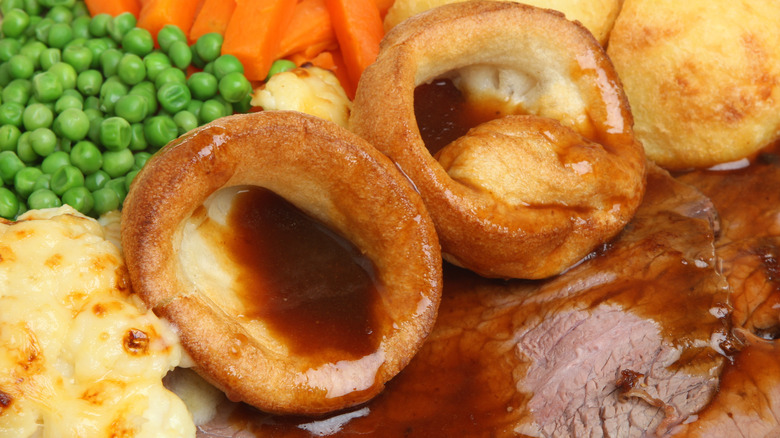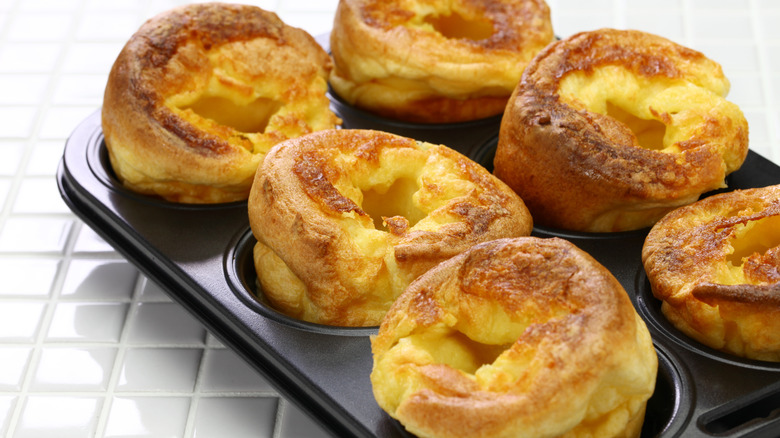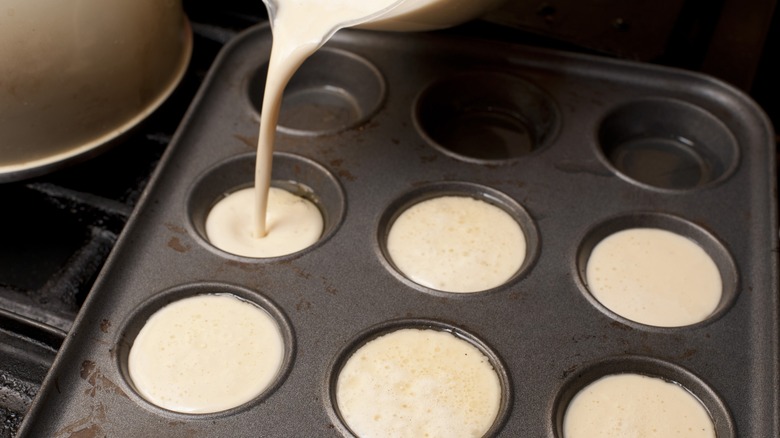The Possible Reason Your Yorkshire Pudding Fell Flat
The pride of the British kitchen – and equally its dilemma — is the fluffy, crispy, golden-brown Yorkshire pudding. Professional and home chefs alike take pride in mastering the art of the "yorkie," a must-have item on holiday tables across the United Kingdom. Whether you like them extra crisp and hollow or slightly dense for cradling gravy, there's one universal horror: watching those lovingly nurtured yorkies flatten before your very eyes.
The culinary shame of a deflated Yorkshire pudding is enough to make many cooks avoid it altogether. But the history of this flaky delight is considerably more humble. The first known recipe for "dripping pudding" appeared in a 1737 publication titled "The Whole Duty of a Woman," according to Yorkshire Pudd. It involved a simple pancake-like batter, a hot pan, some butter, and a shoulder of mutton. For centuries, it remained an ordinary, somewhat flat, toss-up kind of a meal. The artful form we know today evolved over the years, leading to the 2008 declaration by the Royal Society of Chemistry that, "A Yorkshire pudding isn't a Yorkshire pudding if it is less than four inches tall" (per Yorkshire Pudd).
There's no going back now — so let's take a look at the art of yorkie pudds, particularly what can cause yours to fall flat.
Heat, oil, and patience
There's a simple, essential tip for achieving fluffy Yorkshire puddings: Don't open the oven during the cooking process. That means never, according to Jamie Oliver in his YouTube demonstration on making the perfect Yorkshire puddings. Once yorkies enter the oven, they take about 25 minutes to cook depending on the recipe. But opening the door to peek at progress can cause them to suddenly sink, along with your hopes for yorkie perfection. They need to be golden brown, puffy, and crisp before pulling them out of the heat.
But that's not the only thing that will affect the composition of your puddings. Preheating the baking tin with oil is a key element of crispy Yorkshire puddings, according to the BBC, and the type of oil makes a difference. Choose one with a high smoke point, such as a vegetable oil or sunflower oil that holds up well in higher temperatures. This extra heat is important when adding the batter to the hot, oiled tin cups, causing the batter to sizzle and begin cooking. The preheated oil pushes the batter up the sides to give it a lofty lift and puffy composition.
Batter matters
Yorkshire pudding recipes have slight variations, but the batter itself is typically comprised of flour, milk, and eggs of varying types and quantities. The BBC notes that using the white of even one extra egg can make your yorkies taller and crisper. Resting the batter for about an hour gives time for starches to swell and gluten to relax, per Good Housekeeping. This results in an even structure and enhanced rising. For the fluffiest yorkies with hollow insides, leave the batter at room temperature before adding it to the sizzling pan.
Jamie Oliver recommends using a large bowl and whisking the batter (per YouTube). This creates extra air for a fluffy texture that won't fall flat. When it's time to fill the hot, oiled tin cups with batter make sure to resist the urge to overfill each cup. If the batter bubbles over while cooking and runs together across the top of the hot pan, it will drag your Yorkshire puddings down and stop them from adequately rising.
After removing the Yorkshire puddings from the oven, place them away from drafts or any air movement that could cause them to deflate. In fact, GH suggests eating them right away for the ultimate crispness, texture, and warm deliciousness.


